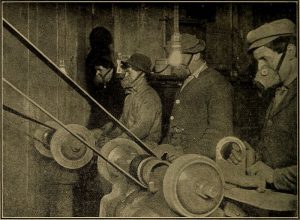The Neolithic Era began between six to twelve thousands years ago, when our ancestors discovered that instead of hunting and gathering, they could live in one place by domesticating plants and animals. The discovery opened the door to a new future for the human species. It began the period of agriculture, metallurgy, and pottery, causing the development of urban life and the growth of the human population. Possibly the first urban settlement was the city of Jericho.1

Jericho is the oldest known city, and today it is known as “The City of Palm Trees.” When one drives through the desert near Jericho, one will come to an oasis and to fertile soil. It is located 900 feet below sea level in the northern part of the Dead Sea, one of the lowest points in the world. Even though that Jericho is currently located in a desert, ten thousand years ago the neolithic village of Jericho was able to grab its water from the mountains of Moab and Gilead, which were 2500 feet above sea level and close to the village. The water would go through underground tunnels to the village, which then used the water for what was probably the first irrigation system in history. Also, the fresh water that came from the mountains gave the village’s fertile farm lands ample water for growing grain, feeding domesticated animals like sheep, goats, and dogs, as well as providing water for the palm tree groves. For its day, Jericho became a most prosperous village, and the only such village in the world.2
Jericho was not only the first of its kind, but also the strongest village in the land. Because of its unique location, it had two important routes: one was to the lands east of the city and the other one to the desert behind it, to the Palestinian coast. The village was also notable for its early pre-pottery settlement (8500-7000 BCE), with buildings made of mud brick, and unique oval shaped walls, which surrounded the whole village to protect the five to thirty families that live in it from outsiders. Their houses and buildings seemed to be well developed with rooms and kitchens. The village of Jericho was built on top of a great mound that was about eighty feet high. Archaeologist have found towers as high as twenty five feet in the village, and various fortified walls, (the walls started from five to six feet high and increase over time) because the original village was never destroyed; the people, instead of destroying it by tearing it down, build another city on top of the previous one that was standing.3 Now, people live in Jericho. It is populated by Palestinians today, but it is also a place where archaeologist and tourist go to find out about the history of our past and about the beginning of the Neolithic Era.
- Kathleen M. Kenyon, “Excavations at Jericho,” The Journal of the Royal Anthropological Institute of Great Britain and Ireland 84, no. 1/2 (1954): 105. ↵
- Kathleen M. Kenyon, “Excavations at Jericho,” The Journal of the Royal Anthropological Institute of Great Britain and Ireland 84, no. 1/2 (1954): 103-5. ↵
- O. Bar-Yosef, “The Walls of Jericho: An Alternative Interpretation,” Current Anthropology 27, no. 2 (1986): 158. ↵



44 comments
Marissa Gonzalez
I found this article very interesting because when I hear of the name Jericho, I think of it in a biblical sense; not as one of the very first cities to ever exist. It seemed like the perfect place to live due to its location. However, it is ironic to know that it is now a desert. It is amazing to know that human civilization started off in that city and to see how much we have grown into what we are today. Seeing human civilization grow and become more industrialized is very impressive. Well done on this article!
Mario Sosa
Whenever I hear about the first ancient city, the first thing that comes to my mind is Mesopotamia. With that being said, I found this article to be most intriguing. It is truly amazing how the oldest known city is still being inhabited to this day, even if the people are living on top of it. All in all, good job on the article!
Briana Bustamante
Such a very interesting topic! I remember hearing about Jericho from the Bible, but it was nice to be informed more with more detail. I find it interesting that about thousands of years ago they were able to grab the water from the mountain and it probably was the first irrigation system in history! I really like the picture that you used of the land. Looking at how it looks now, I wonder how the original village looked. Very well written!
Hayden Hollinger
This is a fascinating article on the first urban settlement of Jericho. I was not aware of the history of Jericho and this article was a detailed background on the settlement. It was also interesting to read about the uniqueness and technology of the settlement which resulted in it lasting for as long as it has! Great job on the article.
Salvador Rodriguez Gomez
It’s cool to learn about the first city and see that it has been preserved in a way with no new group destroying the city and only building on top of it. It’s pretty crazy that it hasn’t been destroyed or gone to ruin like so many other ancient cities. And there are still people living there? That’s awesome! Very interesting and informative article!
Tina Valdez
Previous to reading your article I had very little knowledge about the city of Jericho. I was certainly not aware of the advanced irrigation system they had, which I found to be incredibly interesting. I would not have imagined what might have been the first irrigation system in history to be as advanced as it seemed to be. It was not shocking to read that Jericho was the strongest village in the land after reading about its domesticating animals and irrigation system. Great job!
Esperanza Mauricio
I love the story of Jericho. Knowing that this was the first city to be created is quite interesting and fascinating. I would to visit this place in the future and knowing its history will give it a new wonder if I get the chance to visit.
Yesenia Cardenas
Wow, I never knew the history Jericho. This was definitely a huge accomplishment made in human history. The uniqueness of how the buildings were structured and how the water was gathered from the mountains at the time. Such an interesting topic and very well written, great job!
Rachel White
I find it amazing that instead of destroying the city, new colonies just built over it! I have heard of Jericho in regards to their unique buildings made out of mud and clay, but was not aware of the way in which they utilized advanced waterway systems which is just incredible to me. The brainpower and manpower that would have been needed to construct the advanced underground waterways is something I would be very interested in seeing. Very fun topic. The only thing it could have used was a few more sources, other than that, great job!
Jezel Luna
I was not aware that Jericho was the oldest known city discovered in the Neolithic era. I found it very interesting that the ‘prosperous village’ was made of mud brick and oval shaped walls, which could actually protect five to thirty families…is AMAZING! You showed very well imagery! Can’t wait to see what you have next for us!